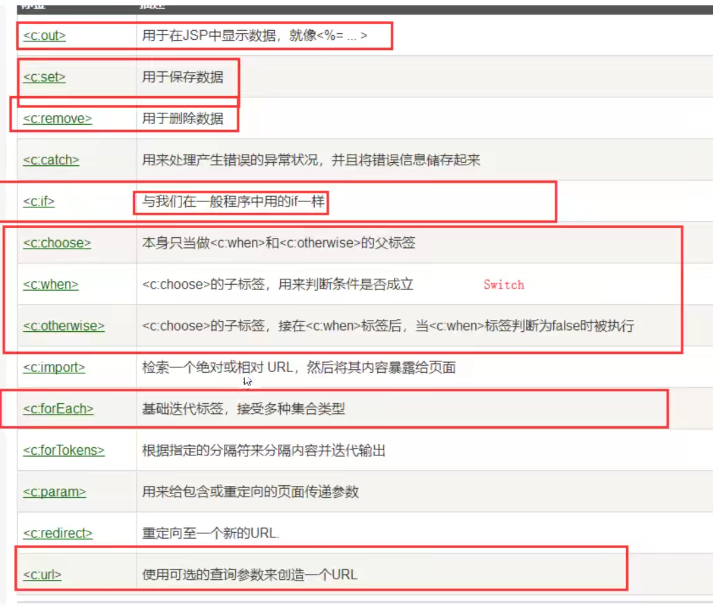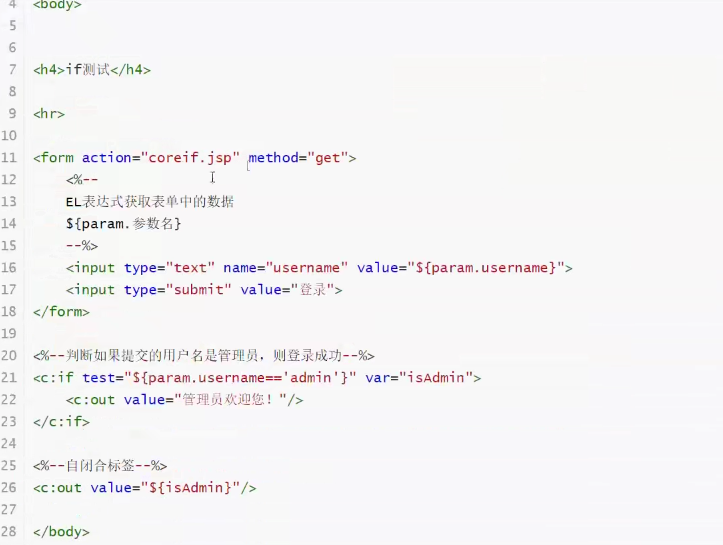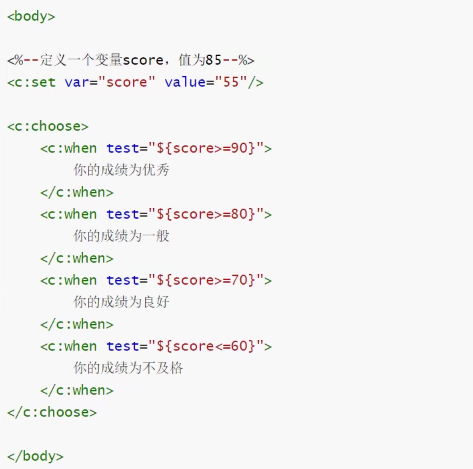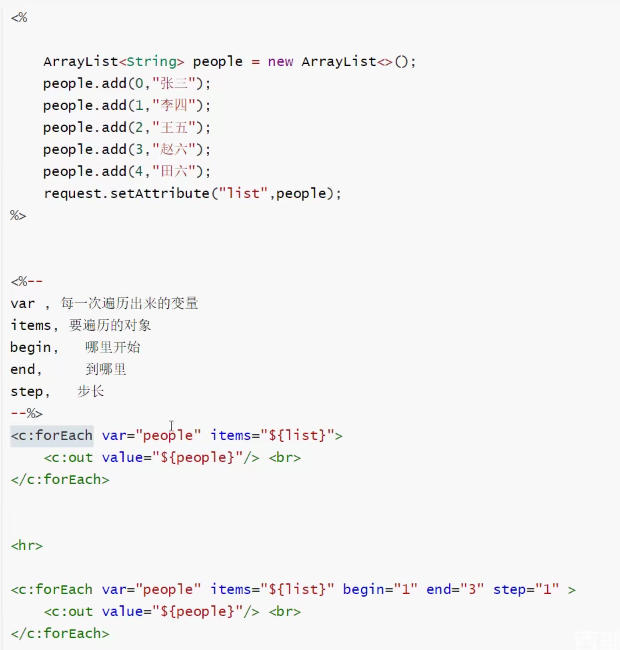一.JSP的基础语法
1 <%--1.JSP表达式 2 作用:用于将程序的结果,输出到客户端 3 语法: 4 <%=变量或者表达式 %> 5 --%> 6 7 <%= new java.util.Date()%> 8 9 <br> 10 11 <%--2.SP脚本片段--%> 12 <% 13 int sum = 0; 14 for (int i = 0; i < 100; i++) { 15 sum += i; 16 } 17 out.print("<h1>Sum=" + sum + "</h1>"); 18 %> 19 20 <%--3.在代码中嵌套HTML元素--%> 21 <% 22 for (int i = 0; i < 5; i++) { 23 %> 24 <h3>hello world <%=i%></h3> 25 26 <% 27 } 28 %> 29 30 <%--4.JSP声明:提升作用域到全局--%> 31 <%! 32 static { 33 System.out.println("Loading Servlet"); 34 } 35 36 private int globalVar =0; 37 38 public void func(){ 39 System.out.println("方法func"); 40 } 41 %> 42 43 <%--5.JSP注释:不会在浏览器的查看源代码中显示,HTML的注释会在浏览器的查看源代码中显示--%>
二.JSP指令
1.手动指定错误页面和使用配置文件web.xml指定错误页面
1 <%-- 可以手动指定错误页面,也可以在web.xml中配置指定错误页面<%@ page errorPage="error/500.jsp" %>--%>
1 <error-page> 2 <error-code>404</error-code> 3 <location>/error/404.jsp</location> 4 </error-page> 5 6 <error-page> 7 <error-code>500</error-code> 8 <location>/error/500.jsp</location> 9 </error-page>
404.jsp
1 <%@ page contentType="text/html;charset=UTF-8" language="java" %> 2 <html> 3 <head> 4 <title>404</title> 5 </head> 6 <body> 7 8 <img src="../img/404.jpg" alt="404"> 9 </body> 10 </html>
500.jsp
1 <%@ page contentType="text/html;charset=UTF-8" language="java" %> 2 3 <html> 4 <head> 5 <title>Title</title> 6 </head> 7 <body> 8 9 <img src="../img/500.png" alt="500"> 10 </body> 11 </html>
2.指定嵌入页面
1 <%@ page contentType="text/html;charset=UTF-8" language="java" %> 2 <html> 3 <head> 4 <title>嵌入头部和尾部页面</title> 5 </head> 6 <body> 7 8 <%--嵌入页面方法一:使用include--%> 9 <%--不会将页面拼接,直接将文件中的内容放在一起,会导致各自页面中的变量可能同名而冲突--%> 10 <%@include file="common/header.jsp"%> 11 <h1>页面主体</h1> 12 <%@include file="common/footer.jsp"%> 13 14 <%--嵌入页面方法二:使用jsp:include标签 (推荐使用)--%> 15 <%--会将页面拼接,各自页面中的变量互不干扰--%> 16 <jsp:include page="common/header.jsp"></jsp:include> 17 <h1>页面主体</h1> 18 <jsp:include page="common/footer.jsp"></jsp:include> 19 20 </body> 21 </html>
header.jsp
1 <%@ page contentType="text/html;charset=UTF-8" language="java" %> 2 <h1>我是头部</h1>
footer.jsp
1 <%@ page contentType="text/html;charset=UTF-8" language="java" %> 2 <h1>我是尾部</h1>
三.JSP的9大内置对象
- PageContext 存东西
- Request
- Response
- Session 存东西
- Application [ServletContext] 存东西
- config [ServletConfig]
- out
- page
- exception
1 <%@ page contentType="text/html;charset=UTF-8" language="java" %> 2 <html> 3 <head> 4 <title>Title</title> 5 </head> 6 <body> 7 8 <%--内置对象--%> 9 <% 10 11 //作用域:page-->request-->session-->application 从小到大 12 pageContext.setAttribute("name1","王1"); //保存的数据只在一个页面中有效 13 request.setAttribute("name2","王2");//保存的数据只在请求中有效,但是如果使用请求转发则可以携带数据 14 session.setAttribute("name3","王3");//保存的数据只在一次会话中有效,关闭浏览器后数据丢失 15 application.setAttribute("name4","王4");//保存的数据只在服务器有效,关闭服务器数据丢失 16 %> 17 18 <% 19 String name1 = pageContext.findAttribute("name1").toString(); 20 String name2 = pageContext.findAttribute("name2").toString(); 21 String name3 = pageContext.findAttribute("name3").toString(); 22 String name4 = pageContext.findAttribute("name4").toString(); 23 String name5 = pageContext.findAttribute("name5").toString(); //不存在的值 24 25 //前台使用pageContext请求转发,后台使用则使用request 26 pageContext.forward("/index.jsp"); 27 //等价于 28 //request.getRequestDispatcher("/index.jsp").forward(request,response); 29 30 //pageContext中可以设置scope作用域参数 31 // public static final int PAGE_SCOPE = 1; 32 // public static final int REQUEST_SCOPE = 2; 33 // public static final int SESSION_SCOPE = 3; 34 // public static final int APPLICATION_SCOPE = 4; 35 pageContext.setAttribute("hello1","你好1",PageContext.SESSION_SCOPE); 36 //等价于 37 // session.setAttribute("hello1","你好1"); 38 39 %> 40 41 <%--使用EL表达式将值输出: ${}--%> 42 43 <h3>${name1}</h3> 44 <h3>${name2}</h3> 45 <h3>${name3}</h3> 46 <h3>${name4}</h3> 47 <h3>${name5}</h3> 48 49 </body> 50 </html>
request:用于用户看完就没有用的数据,例如:新闻
session:购物车案例中使用(一个人使用)
application:聊天数据使用(多人使用)
四.JSP标签、JSTL标签、EL表达式
1.导入包:
1 <!--JSTL表达式依赖--> 2 <dependency> 3 <groupId>javax.servlet.jsp.jstl</groupId> 4 <artifactId>jstl-api</artifactId> 5 <version>1.2</version> 6 </dependency> 7 8 <!--standard标签库--> 9 <dependency> 10 <groupId>taglibs</groupId> 11 <artifactId>standard</artifactId> 12 <version>1.1.2</version> 13 </dependency>
2.EL表达式:${}
- 获取数据
- 执行运算
- 获取web开发常用对象
- 调用Java方法
3.JSP标签:
jsptag1.jsp:
1 <%@ page contentType="text/html;charset=UTF-8" language="java" %> 2 <html> 3 <head> 4 <title>jsptag1</title> 5 </head> 6 <body> 7 8 <h1>jsptag1</h1> 9 <%--jsp:include 用于嵌入页面--%> 10 11 <%--jsp:forward 用于请求转发--%> 12 <jsp:forward page="jsptag2.jsp"> 13 <jsp:param name="name" value="wang"></jsp:param> 14 <jsp:param name="age" value="24"></jsp:param> 15 </jsp:forward> 16 17 18 </body> 19 </html>
jsptag2.jsp:
1 <%@ page contentType="text/html;charset=UTF-8" language="java" %> 2 <html> 3 <head> 4 <title>jsptag2</title> 5 </head> 6 <body> 7 8 <h1>jsptag2</h1> 9 <%--取出参数--%> 10 名字:<%=request.getParameter("name")%> 11 年龄:<%=request.getParameter("age")%> 12 </body> 13 </html>
4.JSTL标签
-
JSTL标签库的使用是为了弥补HTML标签的不足,标签的功能和Java代码一样
(1)根据JSTL标签所提供的功能,可以将其分为5个类别。
-
核心标签(掌握部分)
-
格式化标签
-
SQL 标签
-
XML 标签
-
JSTL 函数

(2)JSTL标签库使用步骤
-
引入对应的taglib的jar包
-
注意:Tomcat中也需要引入jstl的jar 包,否则会报错:JSTL解析错误
c:if

c:choose , c:when

c:forEach

五.Java Bean
